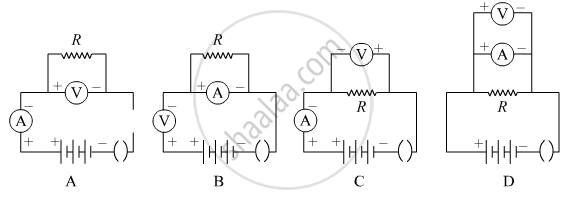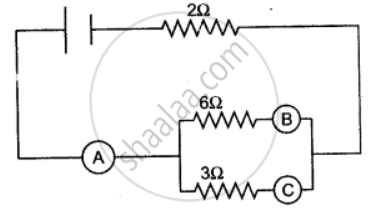Advertisements
Advertisements
प्रश्न
The voltage across a 3Ω resistance is 6 V. How large is the current? What is
the resistance of a filament lamp when a voltage of 3 V across it causes a
current of 0.5 A?
उत्तर
If voltage, V = 6 volt and resistance R = 3Ω
The a/c to ohm's law, current I = `"V"/"R" = 6/3 = 2 "A"`
For filament lamp:
Given that, voltage= 3 V, current= 0.5 A.
let R be the resistance of the filament lamp;
then R = `"V"/"I" = 3/0.5` = 6Ω
APPEARS IN
संबंधित प्रश्न
If a potential difference of 10 V causes a current of 2 A to flow for 1 minute, how much energy is transferred?
The V-I graph for a series combination and for a parallel combination of two resistors is shown in Fig – 8.38. Which of the two, A or B, represents the parallel combination? Give a reason for your answer.
Which one of the following is the correct set-up for studying the dependence of the current on the potential difference across a resistor and why?

In the figure given below, A, B and C are three ammeters. The ammeter B reads 0.5A. (All the ammeters have negligible resistance.)

Calculate:
(i) the readings in the ammeters A and C.
(ii) the total resistance of the circuit.
A current of 0.2 A flows through a conducting wire for 5 minutes. How much charge will flow?
Define electric potential and potential difference.
A battery of 10 volt carries 20,000 C of charge through a resistance of 20 Ω. The work done in 10 seconds is:
Find out the following in the electric circuit given in Figure
- Effective resistance of two 8 Ω resistors in the combination
- Current flowing through 4 Ω resistor
- Potential difference across 4 Ω resistance
- Power dissipated in 4 Ω resistor
- Difference in ammeter readings, if any.

An electric charge always flows from a point at a ______ to a point at a ______.
Name the instrument which is used to measure the potential difference.
